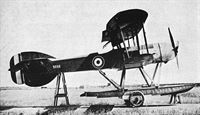P.Lewis The British Fighter since 1912 (Putnam)
Yet another of the unsuccessful single-seat scout prototypes of 1916 was the Wight Baby of J. Samuel White and Company of Cowes. This was a 100 h.p. Monosoupape Gnome-powered single-bay biplane which embodied the double-camber wing section evolved by Howard Wright, and folding wings.
Показать полностью
F.Mason The British Fighter since 1912 (Putnam)
Wight Baby
The established manufacturer of naval aircraft, J Samuel White of East Cowes in the Isle of Wight, was fortunate to possess the services of Howard Wright, a successful designer of long experience. In 1916 he produced a twin-float single-seat scout, much on the lines of the Sopwith Baby, though somewhat larger and heavier.
Of simple, if not crude, design the Wight aircraft was a single-bay biplane with single-acting ailerons on the top wing only; the wings were of unequal span and chord with double-camber, and the tail surfaces were of generous proportions with a large rectangular tailplane and elevator. Being without stagger or cutout, the upper wing obscured much of the pilot’s field of view. However, the 100hp Gnome monosoupape engine, driving a four-blade propeller, bestowed a fairly respectable top speed of about 90 mph at sea level.
The floats were much longer than those of the Sopwith Baby and therefore obviated the need for a tail float; partway through the Wight’s trials these floats were re-fitted further apart to improve stability on the water.
In 1917 one of the three Baby prototypes was flown at Felixstowe, and afterwards underwent Service trials at the Isle of Grain. By then, however, the aircraft’s performance had been thoroughly eclipsed by other in-service naval scouts and it was not developed further.
Type: Single-engine, single-seat, single-bay, twin-float biplane scout.
Manufacturer: J Samuel White & Co, East Cowes, Isle of Wight.
Powerplant: One 100hp Gnome monosoupape engine driving four-blade propeller.
Structure: Wooden box-girder fuselage with fabric and ply covering; two-spar, folding, double-camber, single-bay wings with unequal span and chord; twin three-step wooden floats.
Dimensions: Span, 30ft 8in; length, 26ft 8in; height, 9ft lin; wing area, 297 sq ft.
Weights: Tare, 1,277lb; all-up, 1,864lb.
Performance: Max speed, approx 90 mph at sea level; climb to 6,500ft, 20 min 30 sec; service ceiling, 9,300ft; endurance, 2 1/2 hr.
Armament: None fitted.
Prototypes: Three, Nos 9097, 9098 and 9100. No production.
Показать полностью
J.Bruce British Aeroplanes 1914-1918 (Putnam)
Wight Baby
THE Wight Baby of 1916 was a single-seat seaplane in the same category as the Sopwith Baby. The fact that it had folding wings indicates that it was probably intended for use from ships.
It was a spindly little aircraft powered by a 100 h.p. Gnome Monosoupape rotary engine which drove a four-bladed airscrew. The Wight Baby was structurally conventional: a wire-braced wooden structure was covered almost wholly with fabric. The upper wing was of noticeably greater chord and slightly greater span than the lower; and a seemingly primitive feature at that date was the use of single-acting ailerons, which were fitted to the upper wing only. Presumably it was intended thereby to minimise mechanical complication and to simplify wing folding. The aerofoil was of Howard Wright’s double-cambered section.
The vertical tail assembly was of characteristic outline, and recalled the shape of tail fitted to the big Wight Twin. The tailplane and elevators formed a simple rectangle; the tailplane was braced to the lower longerons by a single strut on either side. The two long shallow floats had three steps and were of sufficient length to hold the tail clear of the water. Each float had a small water-rudder.
In this form the Baby was flown at Felixstowe. It was later sent to the Isle of Grain for trials, by which time it had undergone a number of modifications. A new tail-unit was fitted: the area of the upper fin was increased, a new and taller rudder was fitted, the tailplane and elevators were given raked tips, and an extra strut was fitted to the rear spar of the tailplane. The lateral distance between the floats was increased appreciably, and ailerons of increased span were fitted.
The Wight Baby did not have a particularly good performance, and its abandonment became inevitable when successful flights from ships were made by such aircraft as the Sopwith Pup.
SPECIFICATION
Manufacturers: J. Samuel White & Co., East Cowes, Isle of Wight.
Power: 100 h.p. Gnome Monosoupape.
Dimensions: Span: 30 ft 8 in. (Folded, 11 ft 8 in.) Length: 26 ft 8 in. Height: 9 ft 1 in.
Areas: Wings: 297 sq ft.
Weights and Performance: Date of Trial Report: June 15th, 1917. Type of airscrew used on trial: L.5238. Weight empty: 1,277 lb. Military load: 130 lb. Pilot: 180 lb. Fuel and oil: 277 lb. Loaded: 1,864.1b. Maximum speed at 6,500 ft: 86-5 m.p.h. Climb to 2,000 ft: 4 min 50 sec; to 6,500 ft: 20 min 30 sec; to 10,000 ft: 48 min 30 sec. Service ceiling: 9,300 ft. Endurance: 2 1/2 hours.
Armament: No photograph shows evidence of any kind of armament, but the value of 130 lb quoted above as military load seems to indicate a possible load of two 65-lb bombs.
Production: Three prototypes were ordered under Contract No. C.P.110634/16.
Serial Numbers: 9097, 9098 and 9100.
Показать полностью





